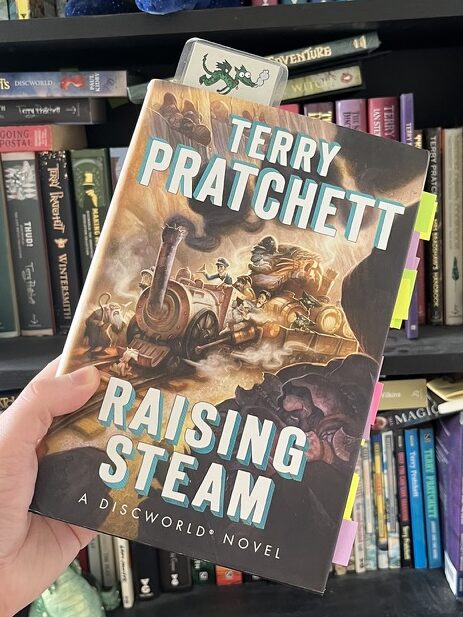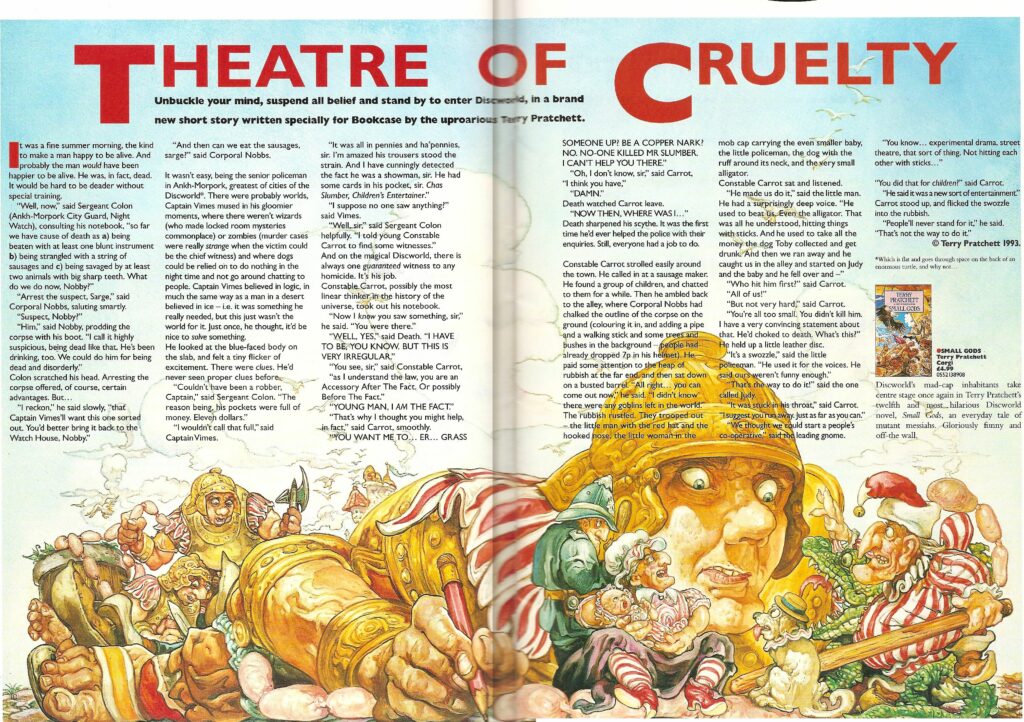#Pratchat90 Notes and Errata
These are the episode notes and errata for Pratchat episode 90, “Mind the Ginnungagap”, discussing the 40th Discworld novel, 2013’s Raising Steam, with returning guest Craig Hildebrand-Burke.
Iconographic Evidence

Notes and Errata
- The episode title makes the obvious gag that Pratchett himself didn’t, combining ginnungagap – the primordial “yawning void” of Norse (and Discworld dwarfish) mythology, from which the world (or one of them, at least) was created – and “mind the gap”, the famous advice on posters and announcements in the London Underground, warning passengers of the gap between the train and the platform.
- As mentioned, Craig was previously a guest on one of our last pre-pandemic episodes: #Pratchat27, “Leshp Miserablés”, discussing Jingo.
- “Gunzel” is uniquely Australian slang for a train or tram spotter – or by analogy, anyone with a specific nerdy interest (though that usage is uncommon). While it has an uncertain etymology, the term is at least several decades old; one account traces it specifically back to employees of the Sydney Tramway Museum in the 1960s, who supposedly picked it up from The Maltese Falcon (as they enjoyed using exaggerated American slang from old films and magazines). Originally used as a insult akin to British terms like “gricer” and “anorak”.
- Melbourne’s City Loop is a central underground railway system passing in a circle through five stations in Melbourne’s central business district (CBD). Until 2025, all major train lines in Melbourne entered the loop on one of four tracks, passing through all of these stations before exiting again. In order to relieve congestion – there are eleven different train lines, but only four tracks in the loop – a new Metro Tunnel project was commenced in 2015 to dig a new tunnel across the CBD, linking the southeast directly to the northwest and creating five new underground stations (some of which are connected directly to the existing ones) in Melbourne and its inner suburbs. Those stations and the new tunnel opened in November 2025, and eventually some of the train lines will stop running around the loop and only run through the tunnel. (While not a true gunzel, Ben is very keen on public transport, so unlike Liz he’s very much looking forward to travelling on the new train route and seeing the new stations.)
- Rob Wilkins gives an account of the writing of Raising Steam in the final chapter of the official Pratchett biography, A Life with Footnotes. He described the process as quite different from the usual, with Pratchett producing many, many scenes, but never getting to the stage of finding the “unifying, crystallising vision that would have turned these scenes into a novel”. He credits Pratchett’s UK editor, Philippa Dickson, with finding the pattern and the gaps in those scenes, and giving Wilkins advice on where to guide Pratchett in order to turn them into a book. Notably not involved was Pratchett’s previous and just as talented and beloved US editor, Jennifer Brehl, as he had only recently switched US publishers from HarperCollins to Knopf Doubleday. (This explains the new cover artist, as seen on Ben’s edition.)
- Train-based fantasy, sci-fi and other fiction that we mention include:
- Perdido Street Station and its sequels The Scar and The Iron Council, weird fiction novels by China Miéville which combine elements of fantasy and steampunk. The Iron Council features trains most prominently of the three.
- Iron Dragon, perhaps the first “crayon rails” style train board game set in a fantasy world.
- Westworld, the television series (based on the 1973 film) about fantasy theme parks staffed by “Hosts”, artificially intelligent robots indistinguishable from humans. The titular “Westworld”, a wild west town, was serviced by a replica steam train, which later plays an important part in the plot.
- Points and Lines, aka Tokyo Express in the newer 2022 English translation, a 1958 Japanese crime novel by Seichō Matsumoto involving trains and timetables.
- The Dark Tower series of novels, specifically The Waste Lands and Wizard and Glass, by Stephen King. These books feature Blaine, an insane artificial intelligence which controls a monorail train. The children’s book which references Blaine is Charlie the Choo-Choo.
- Deadlands is a roleplaying game originally designed by Shane Lacy Hensley. The supernatural ore that powers some of its steampunk technology is called “ghost rock”. The current version is a setting for the Savage Worlds roleplaying game, rather than a game in its own right. Note that like many “weird west” games and stories of the twentieth century, the original 1990s edition contained plenty of appropriation (and misrepresenation) of the cultures of Native and Black Americans; we’re not sure what the later versions are like.
- Spire: The City Must Fall and Heart: The City Beneath, a pair of related tabletop roleplaying games designed by Grant Howitt and Chris Taylor. The class Ben mentions is the “Vermissian Knight”, though Ben got their ability twisted a bit; one of their “zenith abilities” (that are generally a character’s final act) turns them into a living train, who steams off into the Heart (the weird, living dungeon beneath the city of Spire, from which the abandoned Vermissian train system drew its power). The remaining members of their party get a special “Deus Ex Machina” abiltity that they can cash in once to have the train-thing return, smashing into an enemy who is defeating them and dealing massive damage before going on their way again.
- The Peter Grant novels, particularly Whispers Underground, by Ben Aaronovitch. Aaronovitch is a big Pratchett fan, and references the Discworld in most of his novels; he also coincidientally reviewed Raising Steam for The Guardian when it was first published.
- Snowpiercer, a film and subsequent television series, both based on the French graphic novel by Jacques Lob.
- Abiotic Factor, a survival videogame by New Zealand developers Deep Field Games. The Train, also known as “the Steam Engine” or IS-0138 (a designation usually given to creatures or objects, rather than worlds), is noted as “highly dangerous” with the note “IT MUST NEVER STOP”.
More notes coming soon!
Thanks for reading our notes! If we missed anything, or you have questions, please let us know.

